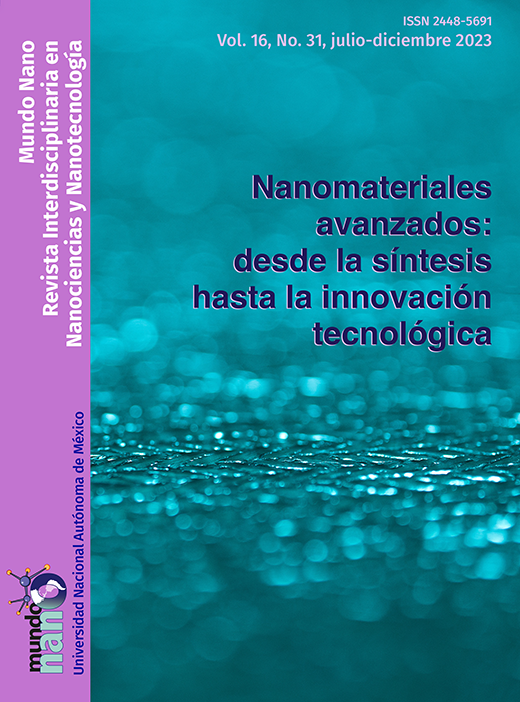A biosensing platform based on graphene oxide and photoluminescent probes: advantages and perspectives
Contenido principal del artículo
Resumen
Biosensing systems are powerful biotechnological tools which are widely applied in medical and environmental settings. Herein, we provide an overview of a recently developed optical biosensing system based on the quenching abilities of graphene oxide and fluorescent bioprobes. This biosensing platform has been demonstrated to be a fast, cost-effective and reliable nanophotonic technology. In particular, it has been exploited to detect relevant analytes in real matrixes, including prostate specific E. coli and COVID-19 antibodies. Besides, this technology enabled the detection of sialidase in clinical samples to determine bacterial vaginosis. This biosensing system has recently been used to determine relevant information on the kinetics of proteins involved in the biorecognition process, everything performed in real-time and in a single step.
Descargas
Detalles del artículo

Mundo Nano. Revista Interdisciplinaria en Nanociencias y Nanotecnología, editada por la Universidad Nacional Autónoma de México, se distribuye bajo una Licencia Creative Commons Atribución-NoComercial 4.0 Internacional.
Basada en una obra en http://www.mundonano.unam.mx.
Citas
Amsel R, Totten PA, Spiegel CA, Chen KC, Eschenbach vD., Holmes KK. Nonspecific vaginitis. Diagnostic Criteria and Microbial and Epidemiologic Associations. Am. J. Med. 1983;74(1):14-22. DOI: https://doi.org/10.1016/0002-9343(83)91112-9
Avila-Huerta MD, Ortiz-Riaño EJ, Mancera-Zapata DL, Cortés-Sarabia K, Morales-Narváez E. Facile determination of Covid-19 seroconversion via nonradiative energy transfer. ACS Sens. 2021;. DOI: https://doi.org/10.1021/acssensors.1c00795
Avila-Huerta MD, Ortiz-Riaño EJ, Mancera-Zapata DL, Morales-Narváez E. Real-time photoluminescent biosensing based on graphene oxidecoated microplates: a rapid pathogen detection platform. Anal. Chem. 2020;2020. DOI: https://doi.org/10.1021/acs.analchem.0c02200
Cortés-Sarabia K, Rodríguez-Nava C, Medina-Flores Y, Marta-Ruíz O, LópezMeza JE, Gómez-Cervantes MD, Parra- Rojas I, Illades-Aguiar B, FloresAlfaro E, Vences-Velázquez A. Production and characterization of a monoclonal antibody against the Sialidase of Gardnerella Vaginalis using a synthetic peptide in a MAP8 format. Appl. Microbiol. Biotechnol. 2020;104:6173-8. DOI: https://doi.org/10.1007/s00253-020-10691-z
Forster T. Energiewanderung und Fluoreszenz. Naturwissenschaften. 1946;33(6):166-75. DOI: https://doi.org/10.1007/BF00585226
Geim AK, Novoselov KS. The rise of graphene. Nature Materials. 2007;6(3):183-91. DOI: https://doi.org/10.1038/nmat1849
Huang A, Li W, Shi S, Yao T. Quantitative fluorescence quenching on antibody-conjugated graphene oxide as a platform for protein sensing. Scientific Reports. 2017;7(1):40772-. DOI: https://doi.org/10.1038/srep40772
Li D, Müller MB, Gilje S, Kaner RB, Wallace GG. Processable aqueous dispersions of graphene nanosheets. Nat. Nanotechnol. 2008;3:101-. DOI: https://doi.org/10.1038/nnano.2007.451
Mancera-Zapata DL. Reduction of graphene oxide and its impact on the performance of a biosensing system. 2018;.
Morales-Narváez E, Merkoçi A. Graphene oxide as an optical biosensing platform. Advanced materials. 2012;24:3298-. DOI: https://doi.org/10.1002/adma.201200373
Morales-Narváez E, Merkoçi A. Graphene oxide as an optical biosensing platform: progress report. Adv. Mater. 2018;31(6):1805043-. DOI: https://doi.org/10.1002/adma.201805043
Najeeb MA, Ahmad Z, Shakoor RA, Mohamed AMA, Kahraman R. Talanta. 2017.
Nugent RP, Krohn MA, Hillier SL. Reliability of diagnosing bacterial vaginosis is improved by a standardized method of Gram Stain interpretation. J. Clin. Microbiol. 1991;29(2):297-301. DOI: https://doi.org/10.1128/jcm.29.2.297-301.1991
Ortiz-Riaño EJ, Avila-Huerta MD, Mancera-Zapata DL, Morales-Narváez E. Microwell plates coated with graphene oxide enable advantageous real-time immunosensing platform. Biosens. Bioelectron. 2020;165:112319-. DOI: https://doi.org/10.1016/j.bios.2020.112319
Ortiz-Riaño EJ, Diana LM-Z, Ulloa-Ramírez M, Arce-Vega F, Morales-Narváez E. Measurement of protein kinetics using a liquid phase-based biosensing platform. Analytical Chemistry. 2022;. DOI: https://doi.org/10.1021/acs.analchem.2c03305
Patel K, Halevi S, Melman P, Schwartz J, Cai S, Singh BR. Biosensors. 2017.
Rodríguez-Nava C, Cortés-Sarabia K, Avila-Huerta MD, Ortiz-Riaño EJ, Estrada-Moreno AK, Alarcón-Romero LC, Mata-Ruiz O, Medina-Flores Y, Vences-Velazquez A, . Nanophotonic sialidase immunoassay for bacterial vaginosis diagnosis. ACS Pharmacol. Transl. Sci. 2021;. DOI: https://doi.org/10.1021/acsptsci.0c00211
Sinclair RC, Peter VC. Modeling nanostructure in graphene oxide: inhomogeneity and the percolation threshold. J. Chem. Inf. Model. 2019;59(6):2741-5. DOI: https://doi.org/10.1021/acs.jcim.9b00114
Srivastava S, Senguttuvan TD, Gupta BK. Highly efficient fluorescence quenching with chemically exfoliated reduced graphene oxide. Journal of Vacuum Science & Technology B. 2018;36(4):04G104-. DOI: https://doi.org/10.1116/1.5026170
Steiner DJ, Cognetti JS, Luta EP, Klose AM, Bucukovski J, Bryan MR, Schmuke JJ, Nguyen-Contant P, Sangster MY, Topham DJ, Miller BL. Array-based analysis of SARS-CoV-2, other coronaviruses, and influenza antibodies in convalescent COVID-19 patients. Biosens. Bioelectron. 2020;169:112643-. DOI: https://doi.org/10.1016/j.bios.2020.112643
Van den Munckhof EHA, van Sitter RL, Boers KE, Lamont RF, Te Witt R, le Cessie S, Knetsch CW, van Doorn L-J, Quint WGV, Molijn A, Leverstein-Van Hall MA. Comparison of amsel criteria, nugent score, culture and two CE-IVD marked quantitative real-time PCRs with microbiota analysis for the diagnosis of bacterial vaginosis. Eur. J. Clin. Microbiol. Infect. Dis. 2019;38(5):959-66. DOI: https://doi.org/10.1007/s10096-019-03538-7
Vasilios Georgakilas JA, , Tucek J, Zboril R. Broad family of carbon nanoallotropes: classification, chemistry, and applications of fullerenes, carbon dots, nanotubes, graphene, nanodiamonds, and combined superstructures. Chem. Rev. 2015;115(11):4744-822. DOI: https://doi.org/10.1021/cr500304f
Velasco-Soto MA, Pérez-García SA, Alvarez-Quintana J, Cao Y, Nyborg L, Licea-Jiménez L. Selective band gap manipulation of graphene oxide by its reduction with mild reagents. Carbon. 2015;93:967-73. DOI: https://doi.org/10.1016/j.carbon.2015.06.013
Vessman J, Stefan RI, Staden JFV, Danzer K, Lindner W, Burns DT, Fajgelj A, Müller H. Selectivity in analytical chemistry: (IUPAC Recommendations 2001). 2001. DOI: https://doi.org/10.1351/pac200173081381
Wu S, Lin X, Hui KM, Yang S, Wu X, Tan Y, Li M, Qin A-Q, Wang Q, Zhao Q, Ding P, Shi K, Li XJ. A biochemiluminescent sialidase assay for diagnosis of bacterial vaginosis. Sci. Rep. 2019;9:20024-. DOI: https://doi.org/10.1038/s41598-019-56371-5





